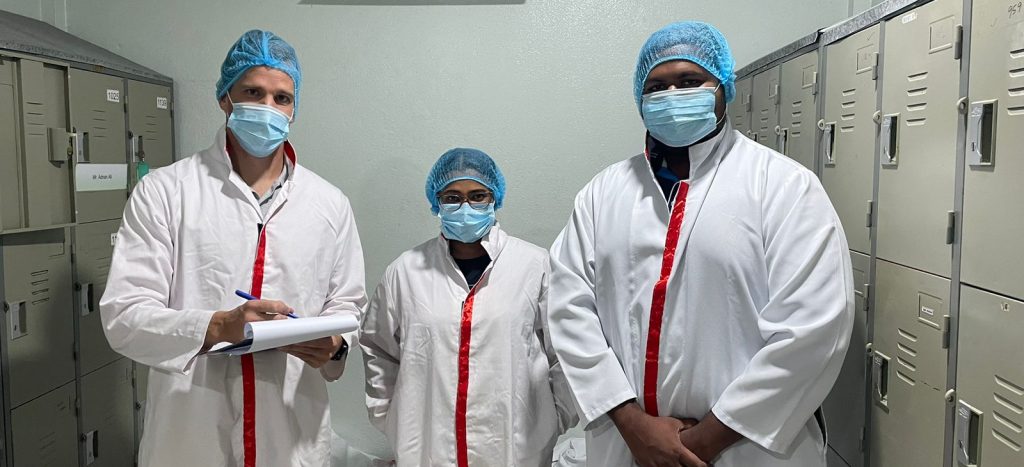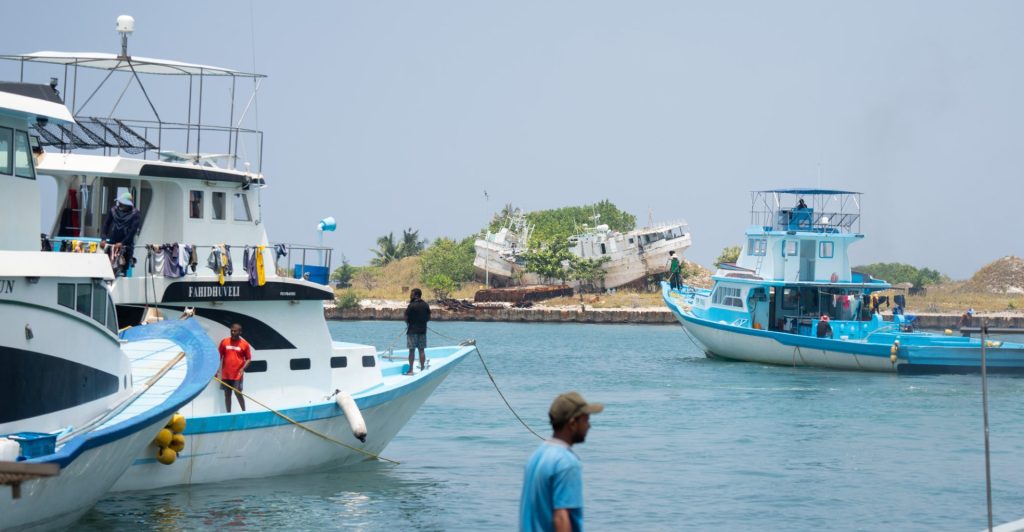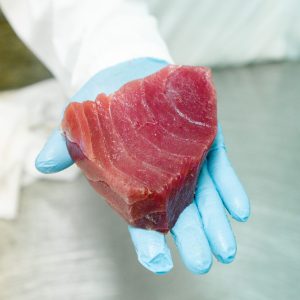Have you ever tried tracking down the farm where your beef, chicken, or vegetables were harvested? Is there a readily available record of the temperatures and locations where your produce was stored? Most likely not. So, you may be surprised to learn that there’s one household supermarket item for which you can verify this information and even more. When you next browse the isles at your local Woolworths, Sainsbury’s, M&S, Migros, EDEKA, or Whole Foods, look out for Maldives tuna.
While planning our “Canspiracy” World Fisheries Day campaign, we sent our communications manager, Stuart Hablutzel, to meet with our IPNLF members and document some of our work in the Maldives. This is what he learned along the way:

Pictured from left: IPNLF team members Stuart Hablutzel, Ubaida Raheema and Ibrahim Saneeh
When I arrived in Himmafushi, a small island near Malé’s capital, my attention was immediately drawn to the impressive handline fleet anchored in the small port at the reef’s entrance. Beautifully styled vessels covered in vibrant blue, red, and green colours signify generations of cultural practice. What a feast for the eyes—not what you’d expect when entering a busy fishing port.

The rather easy-on-the-eye Maldivian tuna vessels busy unloading their catch in port.
Visiting our members’ facilities was an inspiring experience. It left me asking, “Does any food production system in the world pay this much attention to the quality and traceability of their products?” As far as many supermarket items are concerned, I need help thinking of many examples. But with these tunas, I was blown away by how every detail is meticulously recorded at each step of the supply chain; from the moment a tuna is caught in Maldivian waters, it begins its journey to becoming some of the most sought-after tuna in the world. Once caught, the fish start their journey on a strict cold chain that never gets warmer than -1 degree (C). Upon arrival at the port, each fish gets graded through core sampling, and later, sample fish undergo tests for heavy metals on a molecular level. Subsequently, each fish is broken down and processed in an environment comparable to a hospital operating theatre as far as cleanliness matters.

Unloading fresh catch directly to the processing facility, where temperature is logged, and core samples are analysed for quality assurance.

Each tuna’s data is recorded and tagged on the fish.

The fishes information continues to be logged and tracked throughout the process

Final histamine tests and cold storage processes are concluded before delivery.
These days, most supermarket fresh produce suppliers would not risk letting anyone inside their premises (for fear of being featured in another sensationalised-style documentary). However, these facilities welcomed us into their facility and openly showcased their unique processes and technologies that ensure only the highest quality tuna products make it to market. Interesting fact: Fresh Maldivian tuna products make it to supermarket shelves in Europe in 24 hours and in the USA in under 36 hours!

While in the port, I managed to interview a few of the Maldivian fishers, and having interviewed many reluctant fishers in the past, the enthusiasm and openness of the Maldivian fishers was a breath of fresh air. They spoke proudly of their work, their buyers, and the industry. This may be due to their higher-than-average salaries, but it reflects in their work. After a quick tour of a traditional and rather luxurious (by fishing standards) Maldivian one-by-one fishing vessel, it was time to hit the road.

A few of the faces behind some of the best tuna on the planet
Leaving Himmafushi behind me, I kept asking myself whether other fresh produce suppliers could match the efforts and cleanliness in fisheries like this. Could this become the standard by which we measure other food production systems? My inaugural trip to the Maldives offered a unique opportunity to witness the impact of IPNLF’s work firsthand, and I only wish I had more time to dive deeper into each facet of the industry. But I’m sure there will be more on that soon.
I owe a massive thanks to my fellow IPNLF colleagues in the Maldives. Despite being a small team, they are doing a phenomenal job covering fisheries spread over 200 inhabited islands in the Maldives.

This story forms the start of our “Canspiracy” campaign, where we will dive into all things tuna: how we can achieve a sustainable future for these fish and empower responsible fisheries that give back to the seas and the people that depend on them.